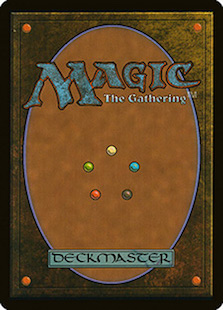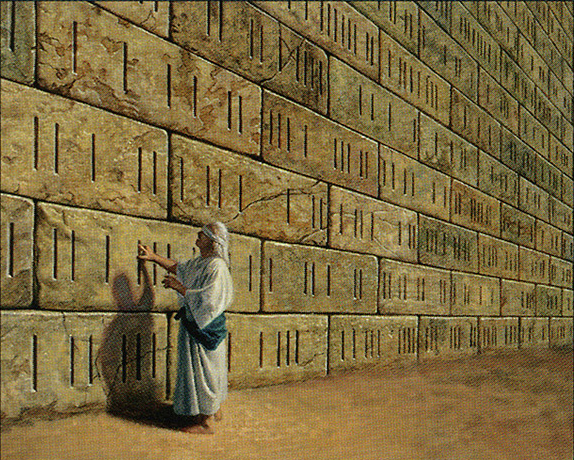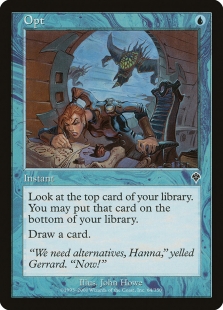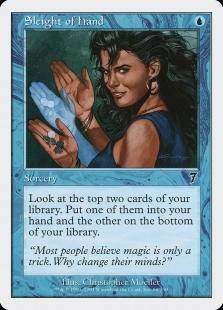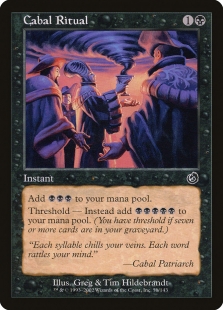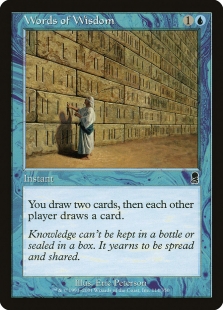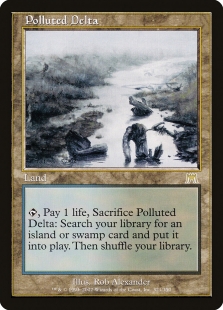Today we have a Bargain Storm deck tech by Per Algander from Uppsala—long-time player, passionate deck brewer and philosopher. This post is the first in a series of deck techs.
Premodern is a format which offers powerful cards to many different archetypes. Should you play control and harness the power of Counterspell, Fact or Fiction and Swords to Plowshares? Or should you turn angry green men sideways and overpower the opponent with Goblin Lackey, Goblin Ringleader, Goblin Warchief and Siege-Gang Commander? Or why not grind the opponent out with Survival of the Fittest? This is just scratching the surface, obviously. In this article I will go through how to play a dedicated storm deck in Premodern. By dedicated I mean a deck whose primary win condition, before and after sideboard, is to cast a spell with the keyword “storm” on it.
The deck
The (main) deck I will be discussing is the following:
There are other ways to build a combo deck in Premodern. Some readers may, e.g., be familiar with the “Burning Bargain” deck which uses rituals, Lion’s Eye Diamond, Yawgmoth’s Bargain and Burning Wish to assemble the Illusions of Grandeur plus Donate combo. I am not going to argue that this archetype, or this sample deck, is superior to Burning Bargain or any other strategy or deck in the format. What I would like to show, rather, is how this deck works and what some of its strengths and weaknesses are.
Key cards
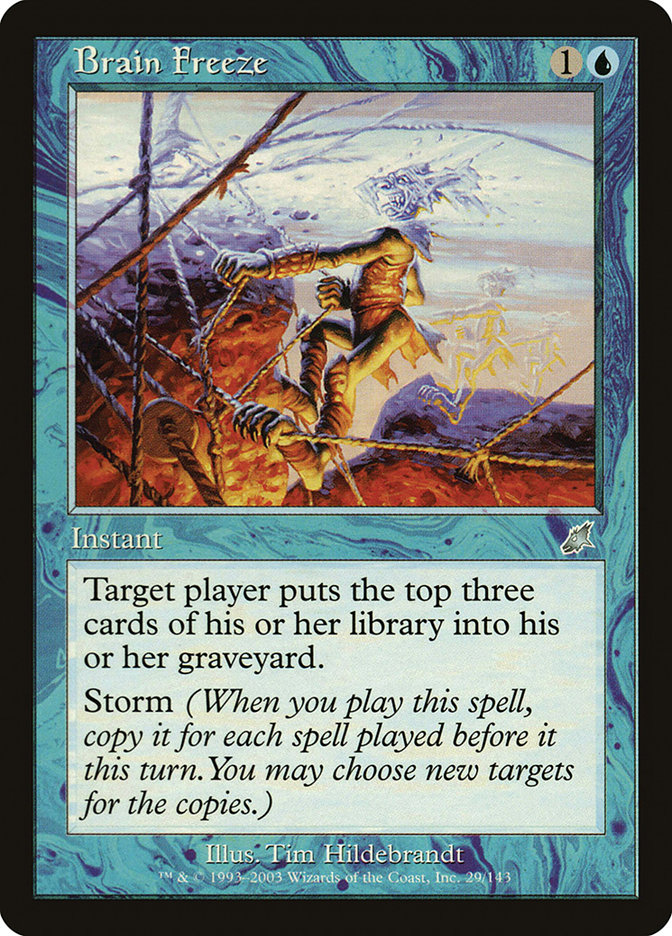
Brain Freeze is the most obvious win condition in a dedicated storm deck in Premodern, since Tendrils of Agony is banned. With Brain Freeze, your aim is to build a sufficiently high storm count and mill the opponent for their entire library, making them lose the game when they draw a card (usually in their draw step).
Milling the opponent with Brain Freeze might seem like a lot of work. After all, each copy of Brain Freeze only mills a player for three cards. Suppose that the opponent has drawn seven cards for their starting hand and have had three draw steps after that. Most people would then have 50 cards left in their library. In order to mill that library you would need to play 16 spells and then a Brain Freeze (17*3 = 51). How do you achieve that?
One way to make it easier to mill the opponent is to play a second Brain Freeze. With two copies, the opponent could be milled by playing seven spells and then two Brain Freeze (8*3 + 9*3 = 51).
In some matchups, however, putting the opponent’s library into their graveyard isn’t enough. Burn can just kill you before they draw their card for the turn, and cards like Scroll Rack can allow a player to put cards back on top of their library indefinetely. Even worse, a deck with Gaea’s Blessing will just shuffle their graveyard into their library when you try to mill them.
There are different ways to approach this problem. In the sample deck above there are two copies of Words of Wisdom. Playing Words of Wisdom after you have milled the opponent makes them lose immediately. This also works against Gaea’s Blessing, but requires some more work. Since Gaea’s Blessing has a trigger when it is put into the graveyard, it is possible to respond to that trigger with a second copy of Brain Freeze. If the second copy mills the opponent’s entire deck, then you can play Words of Wisdom, still with the trigger from Gaea’s Blessing on the stack, and defeat the opponent.
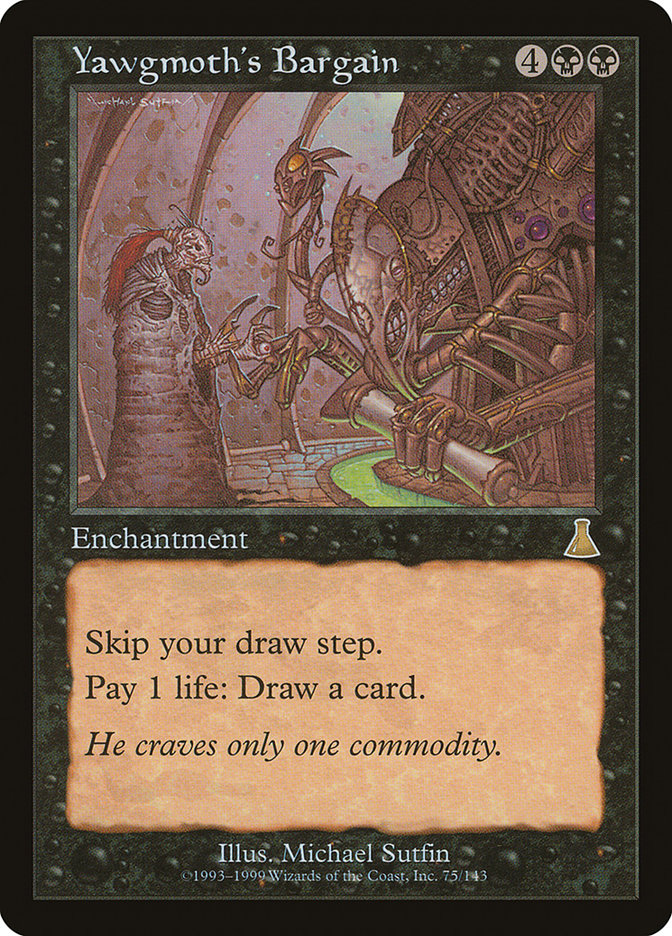
To achieve victory, the storm deck has to play a sufficient number of spells on the same turn. The most obvious way of doing this is by putting Yawgmoth’s Bargain into play. Bargain lets you trade life for cards, thereby (hopefully) giving you enough rituals, zero-mana artifacts and cantrips in order to defeat the opponent with a lethal Brain Freeze.
The deck includes three Intuition in addition the four Yawgmoth’s Bargain. Going for Intuition into Bargain requires nine as opposed to six mana, but it also allows you to use Lion’s Eye Diamond to cast Bargain (sacrifice the diamond with Intuition on the stack).
The power of Yawgmoth’s Bargain is well known, and I am not going to spend much time on it. There are a few things to point out, however. First, don’t draw more cards than you have to. Second, and in particular, don’t draw cards if you don’t have to. If you have good reason to think that you will not lose if the opponent gets another turn, then you need to consider passing the turn. If you have no mana floating, and two or three lands in play, then it can be worth it to pass the turn and take a hit from your opponent’s creatures, even though this means that you will be drawing fewer cards next turn. Third, draw cards one at a time. It is common that you will have to use a Lion’s Eye Diamond to win, and you want to discard as few cards as possible when doing so.
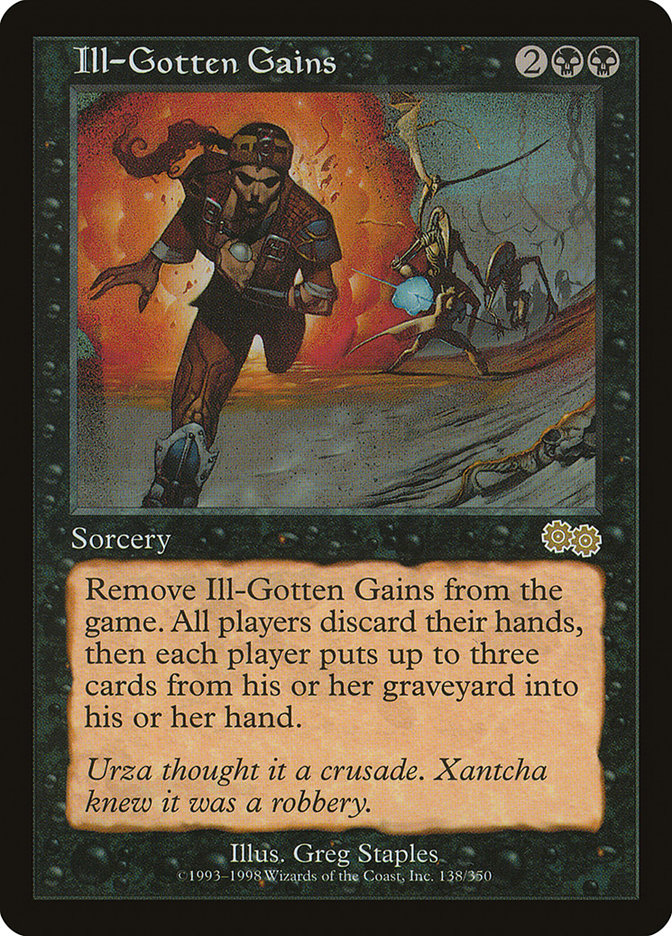
The less obvious way of getting the number of spells you need to defeat the opponent is to cast Ill-Gotten Gains. If you have mana to spare and a Brain Freeze in hand, Ill-Gotten Gains allows you to play the same Brain Freeze twice, thereby cutting the required storm count in half.
Ill-Gotten Gains can also be used to generate mana. Getting back a Dark Ritual and a Cabal Ritual when you have threshold, for example, is effectively to pay four mana for cards that net you five mana (Dark Ritual is +2, Cabal Ritual w/ threshold is +3).
Ill-Gotten Gains is at its best, however, when you have them in multiples. Having access to three or even four Ill-Gotten Gains allows you to build a significant storm count, to the point where a single Brain Freeze can be sufficient to win the game. Since it is likely that you will generate mana each time you cast Ill-Gotten Gains, it is possible to assemble a line of play that will defeat the opponent without relying on the luck of the draw, as is typically the case with Yawgmoth’s Bargain.
The best way of finding multiple copies of Ill-Gotten Gains is Intuition. Casting Intuition at the end of the opponent’s turn for three Ill-Gotten Gains allows you to untap in a position where you are very likely to win.
It is also possible to find multiple copies by casting Brain Freeze on yourself. Putting 12+ cards into your graveyard is likely to include one or two Ill-Gotten Gains. This is of course only a viable plan if you have one copy in your hand.
How to win
Yawgmoth’s Bargain and Ill-Gotten Gains are the two main paths to victory for this deck and they have different strengths and weaknesses. Yawgmoth’s Bargain is the easiest way to win since it only requires access to six mana and Yawgmoth’s Bargain itself. The rest should, hopefully, come off the top of your deck as you draw cards. Ill-Gotten Gains, on the other hand, requires at least five mana (four to cast Ill-Gotten Gains, and at least one to cast a ritual) and either a Brain Freeze, Intuition or a Yawgmoth’s Bargain.
A weakness of Yawgmoth’s Bargain is that how likely you are to win after playing it depends on how much life you have to spare. Ill-Gotten Gains on the other hand does not rely on your life total, allowing you to wait and assemble more other resources with which to win.
Regardless of which path to victory one chooses, it is important to note that while it is easy to get black mana through rituals, one can find oneself stuck without access to blue mana, and hence not being able to cast Brain Freeze. This means that when using Lotus Petal or Lion’s Eye Diamond it’s a priority to choose blue mana.
Deck building choices
The sample deck above is strictly blue-black. However, since the deck plays Gemstone Mine and City of Brass it is easy to fit a third colour in the maindeck or sideboard.
Green is perhaps the colour with the most to offer. Xantid Swarm and City of Solitude against control as well as Hunting Pack as an alternative win condition are possible options. Even Oath of Druids for a transformational sideboard against creature-based decks is a possibility.
White offers Orim’s Chant, which synergises well with Ill-Gotten Gains. Chant is especially good against other combo decks since a chant in response to a Illusions of Grandeur or a Burning Wish can ruin someone’s day.
Other cards that could be considered for either maindeck or sideboard are Rain of Filth, Careful Study, Mox Diamond and Undiscovered Paradise.
Rain of Filth can be a very powerful ritual which also helps towards acheiving threshold. Careful Study, though putting you back a card, nevertheless allows for much needed filtering. The cantrips in the maindeck do not allow you to get rid of cards, so it is possible to get stuck with multiple copies of Yawgmoth’s Bargain for example. Careful Study also helps with threshold. Mox Diamond is a very good card with Yawgmoth’s Bargain. By having Mox Diamond in your deck you are much more likely to draw a zero-mana artifact, making it easier to win even if you don’t have any mana floating when you play the Yawgmoth’s Bargain. Undiscovered Paradise could replace one or two City of Brass. The life loss from the cities do add up, and the drawback from Undiscovered Paradise is sometimes inconsequental in a deck that doesn’t require many lands in play to win.
As for the sideboard, I would recommend being prepared for three things: problematic permanents, counterspells, and red spells.
Chain of Vapor is the most efficient way to deal with a troublesome permanent, though a copy of Teferi’s Realm or two can be good since Chain of Vapor does little against several permanents. Hurkyl’s Recall is the most efficient way to deal with multiple artifacts, such as Sphere of Resistance, Null Rod, Tormod’s Crypt and Tangle Wire.
Xantid Swarm is very good against counterspells, especially since the opponent is likely to take out some creature removal. City of Solitude, Defense Grid and Orim’s Chant are also viable options.
Goblins and Sligh are two of the best aggressive decks in the format and these matchup can be difficult since both decks can conceivably race you. Here, Hydroblast and Chill are two viable options. Note that you probably have 4-6 cards that you can take out in this matchup (Duress and Words of Wisdom), so be sure that you play enough good cards to bring in against these decks.
Appendix: winning lines of play
Required card: Yawgmoth’s Bargain.
Required mana: BB4.
Note: Lion’s Eye Diamond cannot be used.
Required card: Intuition.
Version 1.
Required mana: BBU6.
Play Intuition, get three Yawgmoth’s Bargain.
Version 2.
Required mana: UUBBB10.
Play Intuition, get three Ill-Gotten Gains (mana in pool: UBBB8).
Play Ill-Gotten Gains, get Cabal Ritual, Lion’s Eye Diamond and Ill-Gotten Gains (BU6).
Play Cabal Ritual and Lion’s Eye Diamond (UUUUUBBBBB).
Play Ill-Gotten Gains (sacrifice LED for UUU), get Cabal Ritual, Ill-Gotten Gains and Intuition (BBBUUUU3).
Play Cabal Ritual (UUUUBBBBBBB2).
Play Intuition, get two Brain Freeze and Words of Wisdom (UUUBBBBB2).
Play Ill-Gotten Gains, get two Brain Freeze and Words of Wisdom (UUUBBB).
Play Brain Freeze, Brain Freeze, Words of Wisdom.
Note: This is a “deterministic” win against Gaea’s Blessing. Very mana hungry. Intuition can be played at the end of the opponent’s turn, reducing the required mana to UBBB8. If you don’t need Words of Wisdom, the cost reduces to UBBB9 (or BBB7 with Intuition end of turn).
Required cards: Brain Freeze and Ill-Gotten Gains.
Required mana: UUUBBB3.
Play Brain Freeze, target yourself (UUBBB2).
Play Ill-Gotten Gains, get two Brain Freeze and Dark Ritual (replaceable) (UUB).
Play Dark Ritual and two Brain Freeze targeting the opponent.
Note: The first Brain Freeze (targeting yourself) can be played on the opponent’s turn, reducing the required mana by 1U. This line requires 4-5 other spells (mana and/or cantrips) to build storm count.
Until next time!
– Per
As usual you’re welcome to discuss the article in the Premodern social media channels.
